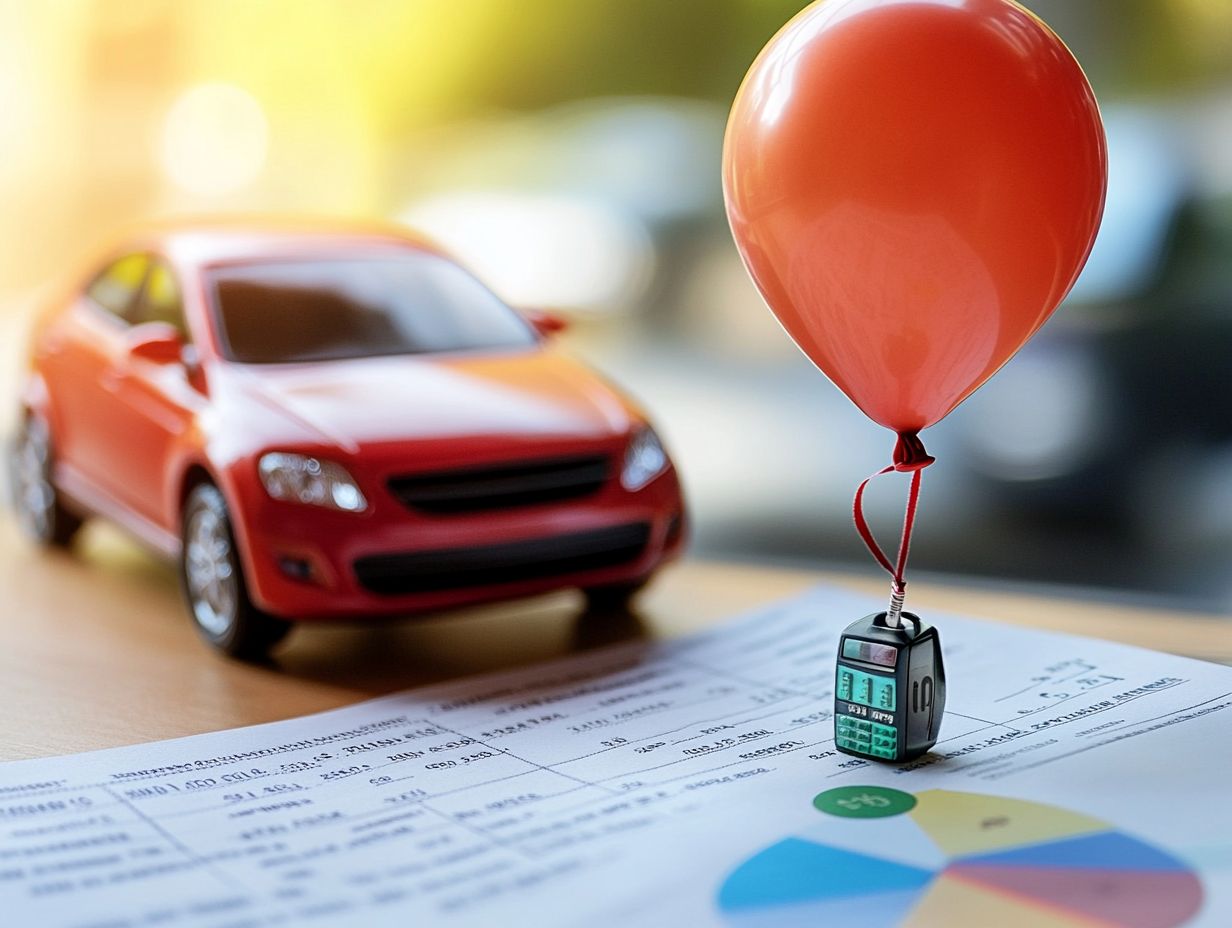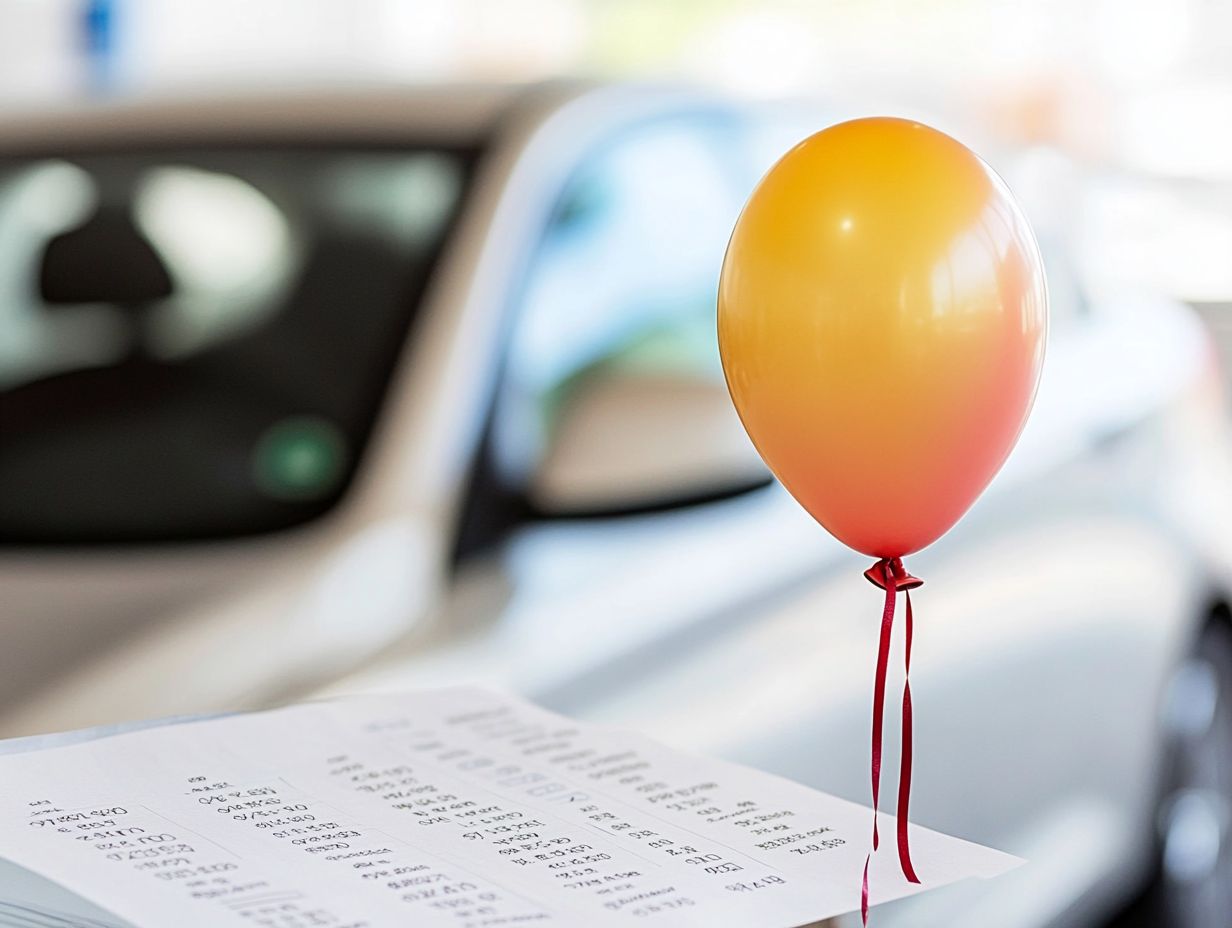Understanding a Balloon Payment in Car Financing
Navigating the world of car financing can be daunting, especially when grasping the details of payment plans.
One crucial concept that often arises is the balloon payment a financing option that can significantly impact your budget.
This piece explains balloon payments, how they work, and their advantages and disadvantages.
We ll also explore alternative options and share practical tips for managing your payments effectively.
By the end, you ll have a clearer understanding, empowering you to make informed decisions about your car financing options.
Contents
- Key Takeaways:
- Overview of Car Financing
- What is a Balloon Payment?
- How Balloon Payments Work
- Pros and Cons of Balloon Payments
- Alternatives to Balloon Payments
- Tips for Managing a Balloon Payment
- Frequently Asked Questions
- What is a balloon payment in car financing?
- How does a balloon payment affect my monthly payments?
- What are the advantages of a balloon payment in car financing?
- What are the disadvantages of a balloon payment in car financing?
- Can I negotiate a balloon payment with the lender?
- Is a balloon payment car loan the right choice for you?
Key Takeaways:

- A balloon payment is a large lump sum due at the end of a car loan. It can lower monthly payments, but it comes with risks and should be carefully considered.
- Understanding the pros and cons of balloon payments is crucial for making an informed decision about car financing. They provide flexibility but also carry the risk of owing a large sum at the end of the loan term.
- If you choose a loan with a balloon payment, plan to pay off the remaining balance. Consider budgeting and exploring alternative financing options to avoid defaulting on the balloon amount.
Overview of Car Financing
Car financing opens up many possibilities for purchasing a vehicle. It allows you to explore various loan types, interest rates, and repayment terms that fit your financial situation.
Grasping the details of car loans is crucial for making informed choices, whether you finance a new car, a used one, or consider leasing. Assess factors like your credit score, trade-in equity, and overall vehicle value to secure the best financing agreement for your needs.
Types of Car Loans
You have several types of car loans to choose from, each tailored to meet different financial needs. These options include traditional loans, leasing, and specialized financing arrangements like personal contract purchases and hire purchases.
Understanding these choices is key for making a well-informed decision. Traditional loans generally involve fixed monthly payments, allowing you to own the vehicle outright once payments are completed, though they may require a larger down payment upfront.
Leasing offers lower monthly payments and the excitement of driving a new car every few years, but you won’t own the vehicle in the end.
The personal contract purchase strikes a balance between ownership and leasing. With this option, you have the chance to buy the car at the end of the term, but you’ll navigate potentially complex terms and extra charges for any excess wear.
Each loan type has its advantages and disadvantages that can affect your financial health. Assess your personal circumstances and long-term goals before committing to any option.
What is a Balloon Payment?
A balloon payment is a specific payment plan with a significantly larger final payment due at the end of a loan term.
It s essential to understand its implications, especially when purchasing a vehicle. Knowing how balloon payments fit into your loans can impact your financial situation and credit score.
Definition and Purpose
A balloon payment is the final payment on a loan that stands out due to its size significantly larger than previous payments. This often occurs at the end of a vehicle financing agreement, allowing for lower monthly payments while requiring careful planning to cover the total amount owed.
The balloon payment structure can be appealing for those prioritizing manageable monthly expenses, especially if you plan to trade in or sell the vehicle before the due date.
By offering lower initial installments, balloon payments enable easier budget navigation. However, this approach isn t without risks; ensure you gather the necessary funds for that final lump-sum payment. Without proactive financial planning, this can feel daunting.
Grasping the details of balloon payments is essential for anyone considering this financing option.
Tip: Consider setting aside a specific amount each month to prepare for the balloon payment.
Evaluate your financing options carefully, and feel free to reach out for assistance if needed!
How Balloon Payments Work

Balloon payments function by structuring the loan so that you make smaller monthly payments throughout the term. This results in a large final payment. It can greatly affect your financial planning.
Payment Structure and Timeline
The payment structure of a balloon payment loan features regular monthly payments that are notably lower than those of traditional loans. This can create financial planning challenges for borrowers.
Typically, these monthly payments cover only interest or a small portion of the principal. This means you could face a large lump sum at the end of the term, which can last from a few years up to a decade. It’s crucial to be aware of the due date for this balloon payment, as it can significantly impact your financial situation.
To handle this, think about these strategies:
- Setting aside funds each month
- Exploring refinancing options
- Restructuring existing debt
Understanding this payment structure helps you avoid surprises when it’s time to pay the final balance.
Pros and Cons of Balloon Payments
The pros and cons of balloon payments create a nuanced landscape that you must navigate when considering them as a financing option for a vehicle.
On one hand, you enjoy the allure of lower monthly payments, which can ease your cash flow. On the other, there’s the looming risk of a substantial final payment that could impact your equity and financial stability.
It’s essential to weigh these factors carefully to ensure your decision aligns with your long-term financial goals.
Benefits and Drawbacks
Balloon payments offer a range of appealing benefits, such as lower monthly payments and enhanced cash flow flexibility, but they also come with their fair share of drawbacks. You need to be aware of the risks, including negative equity and the challenge of managing that substantial final payment effectively.
For instance, while you might relish the reduced monthly financial obligations, it s essential to keep in mind that a significant end-of-term payment looms on the horizon. If you don t plan wisely, this could strain your budgeting efforts, leading to potential repossession and a damaged credit score.
Additionally, a balloon payment structure can limit your equity growth in a vehicle, as much of the financing is front-loaded. Therefore, it s crucial for you to carefully weigh the pros and cons when considering such loan options.
Alternatives to Balloon Payments
Exploring alternatives to balloon payments can reveal financing options that better suit your needs!
Consider:
- Traditional loans
- Leasing arrangements
- Refinancing opportunities
Each of these alternatives can help you manage your monthly payments more effectively, ensuring a smoother financial journey.
Other Financing Options

Traditional loans often offer fixed or variable interest rates over a defined term, allowing you to enjoy predictable monthly payments. On the other hand, leasing agreements provide access to new vehicles or equipment without the long-term commitment of ownership, making it an appealing choice for many.
Refinancing, in contrast, presents the opportunity to secure lower interest rates or adjust loan terms, potentially leading to reduced monthly payments and overall savings.
However, weigh the downsides too, like potential fees and mileage limits with leasing. By understanding your options, you can choose a financial strategy that fits your lifestyle and dreams.
Tips for Managing a Balloon Payment
Managing a balloon payment effectively demands strategic financial planning and foresight. By preparing for that larger final payment, you can avoid significant impacts on your cash balance and overall financial health when it’s time to settle the loan.
Good Strategies for Paying Off the Balloon Amount
Good strategies for addressing the balloon payment involve proactive financial planning, exploring trade-in options, and considering refinancing to ease the burden of the final amount due at the end of the loan term.
Creating a detailed budget is a smart move that can help you manage payments effectively. This ensures you set aside sufficient funds each month for that balloon payment.
Trade-in options can serve as a practical means to offset the balloon payment. They allow you to transition into a new vehicle with reduced financial stress.
Exploring refinancing might reveal opportunities for more favorable loan terms, making payments more manageable. In some cases, selling the vehicle outright can generate enough cash to completely cover the balloon payment, granting you a fresh start and a sense of financial peace.
Frequently Asked Questions
What is a balloon payment in car financing?
A balloon payment in car financing is a lump sum payment due at the end of a loan term. It’s typically larger than regular monthly payments and is meant to pay off the remaining balance of the loan.
How does a balloon payment affect my monthly payments?

A balloon payment reduces the amount of your monthly payments, making them more affordable. However, this means you will have a larger amount to pay at the end of the loan term.
What are the advantages of a balloon payment in car financing?
- Lower monthly payments make it easier to manage your budget.
- It can help you afford a more expensive car that may not be feasible with higher monthly payments.
What are the disadvantages of a balloon payment in car financing?
- The main disadvantage is the large amount due at the end of the loan term, which may be difficult to come up with all at once.
- If you’re unable to make the balloon payment, you may risk losing the car or having it repossessed.
Can I negotiate a balloon payment with the lender?
Yes, you can negotiate the terms of your balloon payment with the lender. Some lenders may be willing to adjust the size of the balloon payment or the interest rate to make it more manageable for you.
Is a balloon payment car loan the right choice for you?
It really depends on your situation and comfort level! If you are confident that you can make the balloon payment at the end of the loan term, it may be a good option for you. However, if you’re unsure or uncomfortable with the potential risk, it may be better to choose a traditional car loan without a balloon payment.






